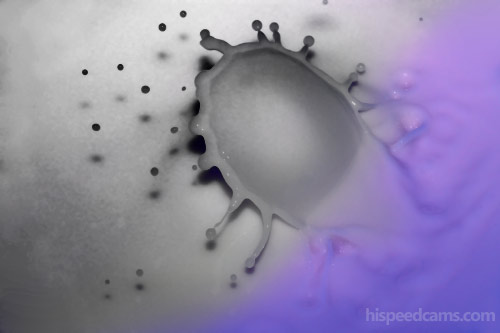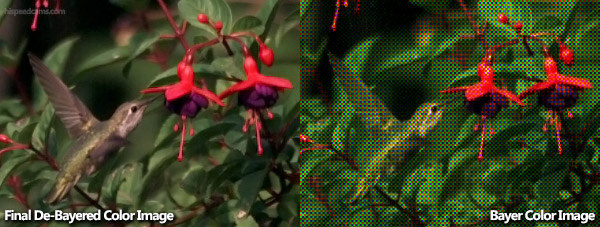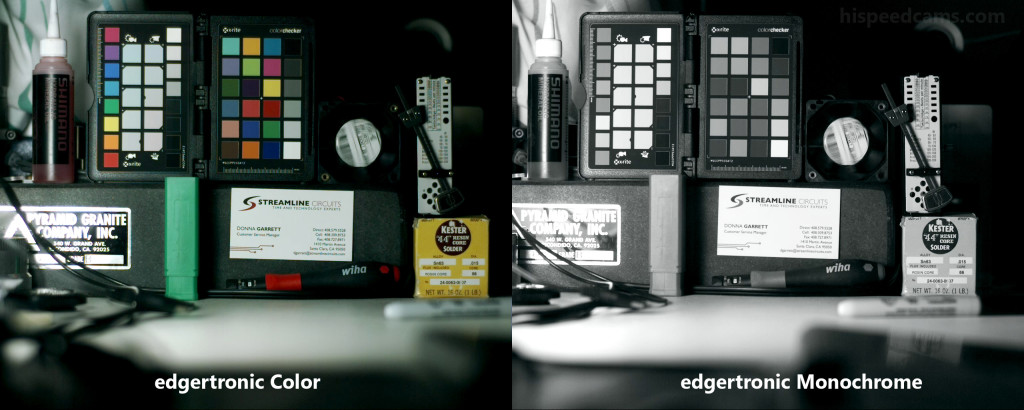
For many of us it seems counter intuitive to own a camera that doesn’t shoot color images. In this day and age of technological marvels, being constrained by black and white / monochrome output on recording is a strange proposition. For the world of high speed imaging however you have to re-examine the entire debate from a benefits point of view and why it could be ideal to have monochrome instead of RGB color as your high speed option.
Depending on the intended use Monochrome might give you more bang for your buck and save you a lot of money on lighting and power requirements to run those lights. To understand the benefits we need to dig in on why Monochrome camera sensors excel in areas where color sensors suffer and why this will hardly change with current sensor technology in the near future.

Monochrome sensors and color sensors are designed mostly identical in most specs with the differences coming in how light is captured by the photosite and stored in the pixel well. The simplified sensor plane above shows the distribution of photosites or pixel areas across the surface to be identical with the difference coming from the Bayer color pattern filter array on the color version.

When photons of light hit the surface of a photosite on a monochrome sensor those photons will mostly pass to the detector and be stored in the pixel well or bucket to be converted to electrical signals and finally as pixel luminance values. The efficiency is very high as there is less of a chance of a photon of light bouncing off the sensor than in a color array.
Color filters for monochrome?
There is a way to capture a color image with any monochrome camera and that is with the use of color filters. By using three exposures with a set of three filters Red, Green and Blue for each take you can combine them in your compositing software later. You will retain image detail by averaging three times as many pixels but will reduce your available light by two thirds or the same as regular color capture. You loose the low light advantages but retain image quality with a bit more noise. For motion imagery especially high speed having three exposures taken is an impossibility as the events might not be perfectly repeatable. Using color filters in monochrome imagery is better suited for still imagery not motion.
Color Sensor:

In the case of a color array sensor plane the light photons collected are filtered by their spectrum characteristics. Any light that does not fit the filter color is discarded and will bounce off while the actual color that passes is retained. The undesirable effect of this is that you can only capture one third “1/3rd” of the light available per photosite compared to a monochrome sensor photosite increasing exposure time considerably for color vs monochrome. The difference can be as high as 2 full stops in favor of monochrome in ideal conditions. Dynamic range in the image is also slightly better by having better noise control in the shadows.
The values captured and stored are then converted by the color photosites into electrical signals and converted by the analog to digital converter to produce pixel values and in the end a final mosaic or Bayer image.

The Bayer or Color Mosaic data is transferred to the logic in the camera and the de-Bayering step is applied in the case of cameras saving in a compressed format. This averaging or inference of pixel values is needed to create final color values on pixels to be applied to a final color image. In the case of RAW color capture the de-Bayering is left to the image processing software in the computer and not done in camera. de-Bayering can be done several ways and some converted preserve more detail than others and aliasing and moire that can occur in de-Bayering can also be reduced if the conversion is tailored to reduce these artifacts. By some estimates the loss in resolution cost due to the Bayer filter is 25-20% loss compared to a direct monochrome capture.

The image above simulates the Bayer pattern on the right and a final de-mosaic or de-Bayered image on the left. The resolution loss compared to a monochrome sensor is substantial and the appearance of color Moire 
So by incorporating a color filter array into a monochrome sensor design you get a color sensor but it will cost resolution and light gathering power. The up to two stop difference can be a game changer when you are light limited for a high speed shoot. For the same exact subject the difference is so great that the amount of light needed by the sensor to capture the scene can be reduced by two factors. In ISO terms a scene that can be exposed correctly at ISO 100 in Monochrome has to be shot at ISO 400 in Color to offer the same exposure in ideal conditions. For the most part you can expect 1.5 stops of difference depending on the camera used.
The benefits considering a camera like the edgertronic for example offer also higher sensitivity. A Color edgertronic camera is noisier and can only use an ISO sensitivity that maxes out at 1600 ISO. The Monochrome edgertronic can work with a sensitivity of 6400 ISO.

In the above example the quality of the image is apparent right away with text showing crisp and readable on the edgertronic Monochrome compared to the color version.
Settings for the example above only Aperture changes:
- shutter 1/500
- resolution 1280x1024px
- 494 fps
- ISO 100
- Color Aperture f4
- Monochrome Aperture f8

edgertronic color vs monochrome video comparison:
Why get a Color High Speed Camera?
Even when monochrome cameras offer much better detail and low light performance there is no substitute for color when you absolutely need it. If you are working with a production company for TV or Cinema and your high speed shot needs to be in color there is no escaping that fact. If your use is intended for advertising and that use must use color which is mostly the case a monochrome camera will be of limited use to you. Having color is the only real benefit of a color high speed camera over the monochrome version and in many cases that is not enough to overcome it’s limitations depending on the use.
Why get a Monochrome High Speed Camera?
Contrary to popular belief the monochrome versions of high speed cameras command much higher sales figures than color. For their low light abilities and detail retention and lack of color moire, these cameras outsell color three out of four times. It is true that color high speed has been getting better performance and a lot of exposure by the Phantom like cameras in TV, the Internet and Movies but the mostly unseen monochrome high speed market is gargantuan in comparison. Laboratories, underwater testing, aviation, very low light environments, night wildlife, scientific experiments and production lines usually care little about color and more about actual detail recorded and low light abilities. Monochrome high speed cameras are here to stay as their performance will remain better than their color versions of the same hardware for the foreseeable future.

In the end the purchasing decision comes to the application at hand. If you absolutely need color the monochrome version of the camera will be of limited use even with the use of color filters on the lens. But if you can spare the color, the monochrome camera might be the best bang for your buck and improve your clarity, low light performance and save you a ton in lighting and file storage in the process.
Thanks to Mike Matter at edgertronic for supplying the sample footage for this article. For more information about the edgertronic monochrome or color affordable high speed cameras please visit: http://edgertronic.com/
Example of the edgertronic being used in a scientific underwater monochrome setup – Aquarius :
